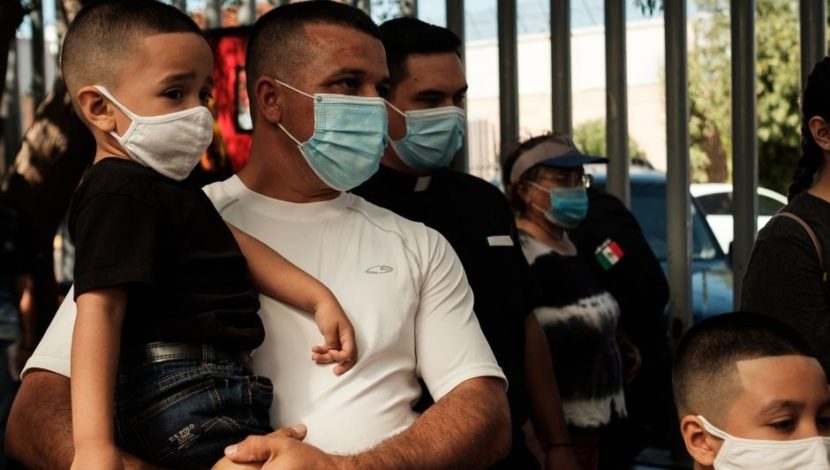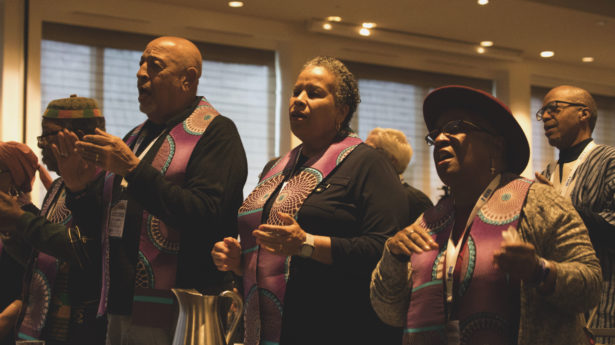The Unitarian Universalist Service Committee advances human rights through grassroots collaborations.
Child Detention is Coming Back: Here’s How to Stop It

By on February 26, 2021
Disturbing news broke this week that the Biden administration plans to reopen and start jailing refugee children again at widely-condemned emergency “influx” facilities under the control of the Office of Refugee Resettlement (ORR), a division of the Department of Health and Human Services. These include a notorious tent city in Carrizo Springs, Texas, as well as a prison-like for-profit facility in Homestead, Florida that was emptied in the summer of 2019 in the wake of a mass movement to expose shocking reports of abuse and shut it down.
The administration’s moves to send children back to these centers is drawing swift and justified outrage. At the same time, due in part to the complicated and confusing nature of how asylum processing works at the border, these actions also provided a fertile ground for disinformation and political spin to take root. Here’s a quick guide to the facts we know so far about the return of child detention—and how we can stop it.
What are these facilities, and who is confined there?
When children arrive at the border without parents or a legal guardian (or separate from a trusted adult in order to present themselves alone), they typically first encounter Customs and Border Protection (CBP), an agency within the Department of Homeland Security. However, CBP is not equipped to care for children and is supposed to transfer custody of unaccompanied minors to the ORR within 72 hours.
Homestead and the Carrizo Springs tent city are both operated by the ORR. These facilities are therefore different from the CBP outposts that were at the center of previous controversies related to migrant children at the border, and where kids have sometimes been kept in deplorable conditions far in excess of the 72-hour limit. In one of these stations, children were held behind chain-link fences and denied basic sanitation—a source of the accounts of kids in cages that shocked the nation’s conscience in the summer of 2019.
However, even if ORR influx facilities are not the same thing as CBP border stations, they are still totally inappropriate places to house children. These facilities are not licensed by state governments to provide childcare, and they are organized and staffed much like prisons. They therefore do not meet the usual standards for regular ORR shelters housing unaccompanied kids, which are generally supposed to be non-securitized (i.e., not prison-like) and licensed to care for children.
So… how is this legal?
Unaccompanied children have special rights under U.S. law and a legally-binding court settlement from 1997 known as the Flores agreement. Both require that the government prioritize the best interests of children it encounters traveling alone at the border. This means that all unaccompanied kids are supposed to be allowed to pursue their case for asylum in the immigration courts, without having to go through the same preliminary steps (such as a “credible fear” interview) that adults must complete.
While doing so, unaccompanied minors are supposed to be released to sponsors in the community, who are often relatives and family members already living in the United States. When this is not possible, children should only be placed in safe, small-scale residential shelters that are licensed to provide childcare by state governments.
However, there is one exception from these requirements, and that is when the government can point to an “influx” of arriving unaccompanied minors that overwhelms current shelter capacity. Under this loophole, the government is able to detain children in unlicensed prison-like “influx” facilities, such as the ones in Carrizo Springs and Homestead.
Does this mean the administration has no choice but to use these facilities?
No. It is certainly true that large numbers of unaccompanied minors are coming to the border, that processing them safely takes time, and that the government’s capacity for housing children is limited. However, the administration could take immediate steps to address these problems, as we explain below, without resorting to the use of heavily-securitized facilities with long track records of abuse.
In the version of events given by administration officials, they are using these problematic “influx” facilities because they rightly do not wish to leave children stranded for prolonged periods in CBP custody (where, as we noted above, conditions are often even worse). They also do not intend to return to the abhorrent Trump administration practice of expelling kids without due process, under the “Title 42” program.
Finally, officials argue that current capacity within the state-licensed childcare facilities is heavily diminished due to COVID-19 protocols that require social distancing. Therefore, they allege, they have no other option but to reopen influx facilities as places to temporarily house kids until they can be safely placed with sponsors.
This narrative is wrong on multiple levels. Many advocates point to the availability, for instance, of large numbers of community-based organizations ready to work with unaccompanied youth; and no circumstances require the government to detain kids in tent cities or prison settings like the ones the ORR is operating.
In any case, however, the administration’s argument leaves out the role their own recent policies have played in creating this crisis to start with.
While the administration has stopped expelling unaccompanied kids under “Title 42,” as discussed above, they continue to use that same policy to block and expel most adults and families at the border. (It is true the administration has started processing some groups of asylum-seekers under previously-standard asylum procedures, but so far these steps have been limited to those who were enrolled in the former “Remain in Mexico” program.)
This means that many children—even if they arrived at the border with parents or other adult relatives—are not able to seek asylum alongside their families. Therefore, parents are faced with two terrible options: either to keep their kids stranded with them in dangerous conditions in Mexico; or, in order to protect their children’s lives and safety, to send them alone into the United States, where they will at least be processed and allowed to pursue their asylum case in court.
It is this unjust “Title 42” policy, therefore, that is forcing so many children to travel alone and end up in the custody of the ORR. If the administration were to stop blocking and expelling these children’s parents and relatives, more families would be able to enter the country together, and capacity in the state-licensed ORR shelters would not be so strained.
So what should we do?
The administration should permanently close these ORR facilities, but they should not stop there. They also need to immediately lift the Title 42 restrictions and restore access to the asylum process for everyone seeking protections—including adults and family units. Moreover, the administration should shut down Immigration and Customs Enforcement (ICE) facilities that are used to detain families. This requires going beyond superficial rebranding and permanently closing ICE facilities in Dilley and Karnes, Texas and Berks, Pennsylvania. This would allow families to travel together to the United States, and work their way through the asylum system in freedom without having to separate from their minor children.
UUSC has started a petition to call on the administration to achieve this by shutting down both ICE family detention centers (which detain parents and kids together) as well as the ORR “influx” detention centers for unaccompanied kids, and ultimately the immigration detention system as a whole.
We must get the word out that locking people up for seeking refuge is never okay—not in ICE, not in CBP, not in ORR; not children, not families, not any person. We must end detention anywhere and everywhere it appears.
***
About UUSC: Guided by the belief that all people have inherent worth and dignity, UUSC advances human rights globally by partnering with affected communities who are confronting injustice, mobilizing to challenge oppressive systems, and inspiring and sustaining spiritually grounded activism for justice. We invite you to join us in this journey toward realizing a better future!
Image Credit: Kino Border Initiative

